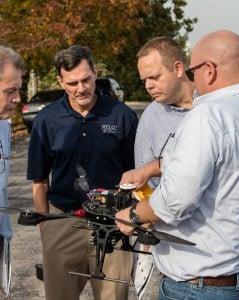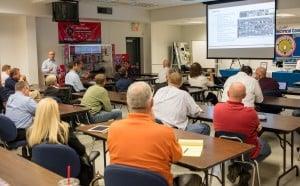 ElectricalConnection.org
ElectricalConnection.org
Connect with Us:
Facebook
LinkedIn
Twitter
YouTube
When you consider the technology that goes into commercial unmanned aerial vehicles (UAV) or drones, you can understand why the Electrical Connection partnership is taking a leading role in training for UAV certification. UAVs are essentially flying robots that integrate wireless communications and controls. Training in advanced manufacturing that relies on robotics, process controls and wireless communications has long been a staple of the Electrical Industry Training Center. 
The training center is operated by the St. Louis Chapter of the National Electrical Contractors Association (NECA) and the International Brotherhood of Electrical Workers (IBEW) Local 1. UAV onboard cameras and other data-gathering and inspection sensors provide IBEW/NECA members a powerful tool that is safe and effective. UAV technologies can be used for thermal imaging to detect electrical infrastructure hot spots in buildings, three-dimensional mapping of topography for precision planning of electrical installations and construction project monitoring of progress and site assets. The construction industry is predicted to lead the commercial UAV market with the 10 largest construction firms worldwide already deploying or experimenting with UAVs.
With that in mind, the Electrical Connection hosted an Oct. 28, 2016 informational session on UAV certification at the IBEW/NECA Electrical Industry Training Center in St. Louis. Working with the Association for Unmanned Vehicle Systems International (AUVSI) — Gateway Chapter and UAViation, IBEW/NECA is developing the region’s first-ever curriculum for commercial UAV certification. This summer, the Federal Aviation Administration (FAA) created a certification process covering the operation of commercial drones which took effect on Aug. 29, 2016. The number of commercial UAVs will grow from 600,000 units in 2016 to 2.7 million by 2020. The new FAA rules are designed to minimize risks to other aircraft, people and property on the ground. Annual worldwide UAV production is predicted to rise from $4 billion to more than $14 billion by 2026. 
Certification at the training center will be open to appropriate industries using commercial UAVs. This includes first responders, real estate firms, agriculture, media and film makers, civil engineering civic entities and others. For example, agriculture and land management enterprises might use UAVs equipped with special sensors to analyze crop health or water quality. First responders may use UAV’s equipped with thermal sensors to detect human heat signatures in search and rescue operations. 
The new FAA small UAV regulations are outlined in a 624-page rule book and include a number of limitations for commercial UAV use. For example, the maximum weight limit for a commercial drone is 55 pounds and it’s limited to altitudes of 400 feet with a few exceptions. Drones may also not be flown out of visual contact.
IBEW/NECA electrical and communication training spans more than 70 years and has been continuously adapted to new technologies like UAVs. Training was refined at the dawn of the Information Age and for data storage, building automation, wireless integrated communications, electric vehicles and robotics. It is the prime reason why the Electrical Connection partners with visionary organizations like AUVSI-Gateway Chapter so its workforce is always prepared to safely and proficiently install the technologies we will rely on in the future.
Recent News